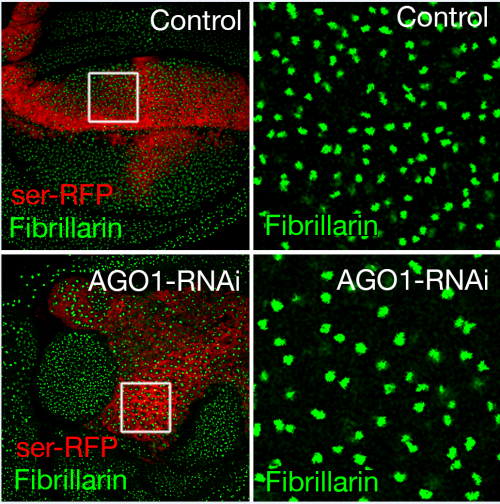The people behind the papers – Olga Zaytseva and Leonie Quinn
Posted by the Node Interviews, on 1 December 2020
This interview, the 83rd in our series, was published in Development earlier this year.
Unregulated cell proliferation can be disastrous for development and underlies the progression of cancers throughout the lifespan. A new paper in Development dissects the molecular regulation of a key cell proliferation promoter (and infamous oncogene) Myc, using Drosophila as a model system. We caught up with Olga Zaytseva, recent PhD graduate and one of the paper’s first authors, and her supervisor Leonie Quinn, Associate Professor at the John Curtin School of Medical Research in Canberra, to find out more.

Leonie, can you give us your scientific biography and the questions your lab is trying to answer?
LQ After my PhD studies in Adelaide I conducted postdoctoral research at the Peter MacCallum Cancer Centre, investigating growth and cell cycle control. In 2007, I established my own group at the University of Melbourne, and later relocated to the John Curtin School of Medical Research in Canberra. My laboratory uses Drosophila to elucidate molecular mechanisms patterning cell and tissue growth during animal development. Our interest in RNA-binding proteins ‘moonlighting’ in transcriptional roles began over a decade ago when we demonstrated the splicing factor Hfp inhibits cell growth through transcriptional repression of the master regulator of growth, Myc. Subsequent studies revealed that a second splicing factor, Psi, also interacts with RNA Polymerase II machinery, in this case activating Myc transcription to promote cell and tissue growth. In our current paper, we report that the Argonaute family RNA binding protein, AGO1, functions outside of canonical functions in the miRNA-dependent RNA-induced silencing complex (RISC), repressing Myc transcription to inhibit cell and tissue growth.
And Olga – how did you come to work in Leonie’s lab and what drives your research today?
OZ During my undergraduate studies at Melbourne University on a path to a medical degree, I became particularly fascinated by studies of animal development, so I decided to seek out opportunities for research experience in this area. After seeing several beautiful images of the Drosophila wing on the Quinn lab website, I decided to approach Leonie and with her help I was lucky enough to receive a summer studentship to complete a short project on the roles of the transcription factor ASCIZ, previously uncharacterised in flies. I felt very inspired by Leonie’s passion, and this experience of the excitement and rewards of scientific enquiry motivated me to continue on to Honours and then a PhD degree under Leonie’s supervision. My PhD, which I have recently completed, gained insights into how the transcription regulator and single stranded DNA/RNA binding protein Psi acts to control growth and development. From the studies conducted in our lab, I am particularly interested in how transcription regulators such as Psi are able to control particular networks of genes in different cell and tissue types.
How has your research been affected by the COVID-19 pandemic?
OZ & LQ We feel quite fortunate in Australia, given the low number of cases and the stringent measures taken by the government to prevent the spread of infection and to widely test the population. The preventative lockdown measures meant that we’ve had limited access to the lab for several weeks, but given that many lives have been saved as a result of the restrictions, they are entirely warranted. Procedures are already underway to resume operations which means it’s not too long until our experiments can be gradually commenced again.
Let’s get to your current paper then – what was previously known about the link between Myc, Argonaute proteins and growth control?
OZ & LQ Although Myc is a well-established regulator of cell and tissue growth in both mammals and Drosophila, the links between AGO1 and Myc-driven growth have not been investigated. AGO1 proteins have been most thoroughly characterised as having roles in the RISC, where they are guided by the sequences of particular miRNAs/miRs to degrade target mRNAs. The regulation of Myc mRNA via RISC and miR-308 has been previously demonstrated by Julie Goodliffe’s group in Drosophila embryos; however, many miRs have tissue-specific targets and our work has shown that in the context of the wing, AGO1 does not control Myc via a RISC-dependent mechanism. Our study adds to the body of work that implicates Argonaute proteins in transcriptional control within the nucleus, for example via Polycomb Group transcriptional repressors.

Can you give us the key results of the paper in a paragraph?
OZ & LQ We have discovered a previously unreported role for AGO1 as a repressor of Myc transcription and, as a result, growth of the Drosophila wing. We depleted AGO1 specifically in the developing wing, and observed strikingly increased ribosome biogenesis, nucleolar size and cell growth. AGO1 physically interacts with a key regulator of Myc transcription, Psi. AGO1 depletion increased Myc mRNA and protein levels, and the overgrowth seen after AGO1 knockdown was dependent on Psi and Myc. Given the roles of AGO1 within RISC, we tested whether Myc was increased via the most likely miR candidates; however we did not observe changes to Myc mRNA after manipulation of miRs. Instead, we saw that AGO1 depletion promotes the RNA Polymerase II transcription of Myc, and that AGO1 directly associates with the Myc promoter.
Do you have clues as to how, at a molecular level, AGO1 inhibits Myc transcription?
OZ & LQ We saw that overgrowth as a result of AGO1 knockdown was dependent on Psi; therefore a likely possibility is that the interaction between AGO1 and the Myc promoter might repress the activity of Psi. The mammalian orthologue of Psi, FUBP1, acts to remodel single-stranded DNA at the MYC promoter which enables maximal RNA Polymerase II transcription. However, links between human AGO1 and FUBP1 have not been studied and would be interesting to follow up in the future. We also saw overlap between AGO1 and Polycomb in the nucleus, and given that previous studies implicated Polycomb in the autorepression of the Myc gene in response to elevated Myc, Polycomb may play a role in AGO1-mediated Myc repression in certain contexts. Furthermore, AGO1 is an RNA-binding protein – the repression of the Myc promoter may occur by recruitment of non-coding RNAs that restrict transcription.
Too much Myc expression is associated with most human cancers – might AGO1 be a useful way to dampen this activity?
OZ & LQ While increased levels of Myc are clearly important for tumour progression, the links between AGO1 and cancer are not well established. Across different tumour types, AGO1 can be either overexpressed or contain loss-of-function mutations, suggesting either oncogenic or tumour suppressive roles depending on the context. The wing epithelium, where we observed tumour suppressive activity of AGO1, provides insights into progression of epithelial tissue cancers such as breast or prostate. A further understanding of how AGO1 is recruited to the Myc promoter would be required to develop strategies that stimulate AGO1 Myc-repressive activity. However, given the potent Myc activation as a result of AGO1 knockdown, harnessing the repressive roles of AGO1 to inhibit cancer growth is an exciting prospect.
When doing the research, did you have any particular result or eureka moment that has stuck with you?
OZ For me, it was seeing the overgrown cells after AGO1 depletion: that was the moment which started the enquiry into how it might occur. Once we began to characterise the phenotype, including elevated ribosomal RNA, ribosomal proteins and increased nucleolar size, we gained more clues that pointed towards a link with Myc. Given the crucial roles Myc plays in many cancers, it’s exciting that we discovered a mechanism which could contribute to cancer progression.
And what about the flipside: any moments of frustration or despair?
OZ When seeking to determine whether AGO1 interacts with chromatin in the Drosophila wing, we initially took a genome-wide approach. However, after making the constructs and performing the sequencing, we didn’t get any enrichment signal, which was quite disappointing. Therefore we looked at the Myc promoter specifically and were able to observe AGO1 binding. However, any clues as to AGO1 transcriptional targets more widely in the cell would have been highly informative, and it’s an experiment we’d like to perform in the future.
What next for you after this paper?
OZ I’m very interested in the protein that led us to AGO1, Psi. Both Psi and the mammalian orthologue FUBP1 appear to play versatile roles in binding RNA and single-stranded DNA at promoters. In fact, there are many examples of proteins that originally were thought to exclusively bind RNA but were subsequently found to associate with DNA as well. This highlights the dynamic nature of DNA, which often doesn’t get considered – the textbook ‘double helix’ is in fact just one of the conformations, while many other arrangements of the DNA strands play significant regulatory roles. Understanding how proteins such as Psi interact with such structures is important for a full picture of transcriptional control. As a first step, we are investigating genome-wide targets of Psi which led us to the discovery that Psi regulates multiple genes with roles in growth and developmental patterning.
There are many examples of proteins that originally were thought to exclusively bind RNA but were subsequently found to associate with DNA as well.
Where will this work take the Quinn lab?
LQ Based on this work we will continue to investigate the nuanced context-dependent control of transcription by single-stranded DNA/RNA-binding proteins, which is a key interest of our lab.
Finally, let’s move outside the lab – what do you like to do in your spare time in Canberra?
LQ I voraciously read non-fiction – history and politics of all flavours.
OZ I enjoy getting outdoors to explore the many parks and forests around Canberra.


 (No Ratings Yet)
(No Ratings Yet)